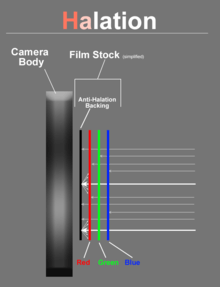Anti-halation backing
An anti-halation backing is a layer found in most photographic films. It is usually a coating on the back of the film base, but sometimes it is incorporated between the light-sensitive emulsion and the base. The light that passes through the emulsion is absorbed by the anti-halation layer. This prevents any light from being reflected back through the emulsion from the rear surface of the base, or from anything behind the film, such as the pressure plate of the camera, and causing a halo-like effect around bright points or edges in the image.

Still cameras, which handle less film and thus contend with less wear, typically hold their film in the gate with components painted or treated to be black, so reflections are less of an issue and few still films made use of anti-halation backings. The notable exception was Kodak's Kodachrome, which incorporated such a backing to aid with a very sensitive innermost layer.
The anti-halation layer is rendered transparent or washed out during processing of the film, for example, the K-14 process for Kodachrome still film and the Eastman Color Negative (ECN2) process for color motion picture film both have steps which remove this layer.
The lack of an anti-halation layer in Kodak High-Speed Infrared (HIE) film caused the ethereal "glowing" effect often associated with infrared photography,[2] rather than an artifact of IR itself.
References
- "Halation on Film & Digitally Imitating It". Prodigium Pictures. 2019-06-15. Retrieved 2019-06-16.
- "PhotoNotes.org Dictionary - Anti-halation layer". Archived from the original on 2016-08-21. Retrieved 2009-07-21.
- "Anti-Halation Backing Removal". Vimeo. Retrieved 2019-06-16.
- "On Color Science". www.yedlin.net. Retrieved 2019-06-16.